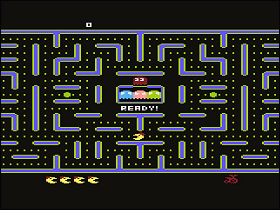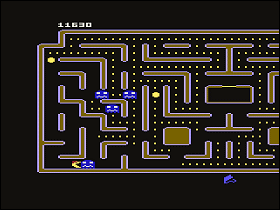
 The Game: As the offspring of a round yellow creature consisting of a mouth and nothing else, you maneuver around a bigger maze than your parents ever had to deal with, gobbling small dots and evading four colorful monsters who can eat you on contact. Six large flashing dots in the maze enable you to turn the tables and eat the monsters for a brief period. Periodically, assorted toys will begin hopping through the maze, turning every uneaten dot they touch into a larger dot which yields more points, but also forces little Pac to slow down to digest them. The monsters, once eaten, return to their home base in ghost form and return to chase you anew. If cleared of dots, the maze refills and the game starts again, but just a little bit faster… (Atari, 1984; released by AtariAge.com, 2003)
The Game: As the offspring of a round yellow creature consisting of a mouth and nothing else, you maneuver around a bigger maze than your parents ever had to deal with, gobbling small dots and evading four colorful monsters who can eat you on contact. Six large flashing dots in the maze enable you to turn the tables and eat the monsters for a brief period. Periodically, assorted toys will begin hopping through the maze, turning every uneaten dot they touch into a larger dot which yields more points, but also forces little Pac to slow down to digest them. The monsters, once eaten, return to their home base in ghost form and return to chase you anew. If cleared of dots, the maze refills and the game starts again, but just a little bit faster… (Atari, 1984; released by AtariAge.com, 2003)
Memories: A victim of former Commodore executive Jack Tramiel’s takeover of Atari‘s home video game and computer division, Jr. Pac-Man was one of the many “orphaned” games that were finished and ready for mass-production, but despite the money that had been spent on acquiring the license and developing the actual software, Jr. Pac-Man stayed off the schedule, never to hit the stores.
At Commodore, Tramiel had initiated price-slashing measures to ensure that the Commodore 64 outsold any other personal computer on the market at the time, including Atari’s own 8-bit line, and several small computer manufacturers went under as they tried to keep up with the C64’s low price point. But the low prices also affected Commodore itself, and amid rumblings of a revolt by the company’s board of directors and shareholders, Tramiel hit the door. As legend would have it, he bought Atari’s consumer division with the idea of turning it into a computer superpower in order to get back at Commodore’s board, whom he percevied to be ungrateful for his cutthroat tactics on their behalf.
One of the first things Tramiel did at Atari was to put new game development in a deep-freeze. This included the finished-and-ready-to-ship Atari 7800 console – which Atari, prior to the sale to Tramiel, had conducted extensive market research to create – and dozens of titles for all three of Atari’s active consoles. In 1987, facing a cash crunch, Tramiel grudgingly allowed the 7800 to be shipped, despite the fact that Nintendo had seized the majority of the market in Atari’s absence from the home video game sphere.
 One of the games put on ice was a 5200 port of Jr. Pac-Man, which was also ported for the Atari 2600 (that version, at least, was released – as a budget title alongside a re-packaged, lower-price-point 2600 console). The 5200 version is as close to flawless a console version as anyone could make in 1984: the maze scrolls smoothly, and the game plays almost exactly like its arcade counterpart… with one important distinction.
One of the games put on ice was a 5200 port of Jr. Pac-Man, which was also ported for the Atari 2600 (that version, at least, was released – as a budget title alongside a re-packaged, lower-price-point 2600 console). The 5200 version is as close to flawless a console version as anyone could make in 1984: the maze scrolls smoothly, and the game plays almost exactly like its arcade counterpart… with one important distinction.
A long-standing mainstay of the Pac-Man arcade games is that Pac-Man (or whatever member of his family is appropriate to a given game) speeds up slightly when he makes a corner, gaining a little bit of ground on the ghosts. This is fairly important in Jr. Pac-Man, because the bouncing bonus prizes turn normal dots into larger dots that slow Jr. Pac-Man down (poor little guy has a harder time digesting them). The corner-speed-boost is more important in Jr. Pac-Man than in any other game in the series, since it levels the playing field – and with its omission here, the deck is stacked in favor of the ghosts. This is almost the hardest version of Jr. Pac-Man there is.
 Had Jr. Pac-Man been released on schedule, there’s no doubt that arcade enthusiasts would’ve been high-fiving Atari for a great arcade port, even if the Pac-Man series was slightly old hat by ’84. But as things happened, the game never got the chance to win that acclaim; it would have to wait for a “posthumous” (at least as far as Tramiel’s Atari was concerned) release in the 21st century, courtesy of AtariAge.com.
Had Jr. Pac-Man been released on schedule, there’s no doubt that arcade enthusiasts would’ve been high-fiving Atari for a great arcade port, even if the Pac-Man series was slightly old hat by ’84. But as things happened, the game never got the chance to win that acclaim; it would have to wait for a “posthumous” (at least as far as Tramiel’s Atari was concerned) release in the 21st century, courtesy of AtariAge.com.